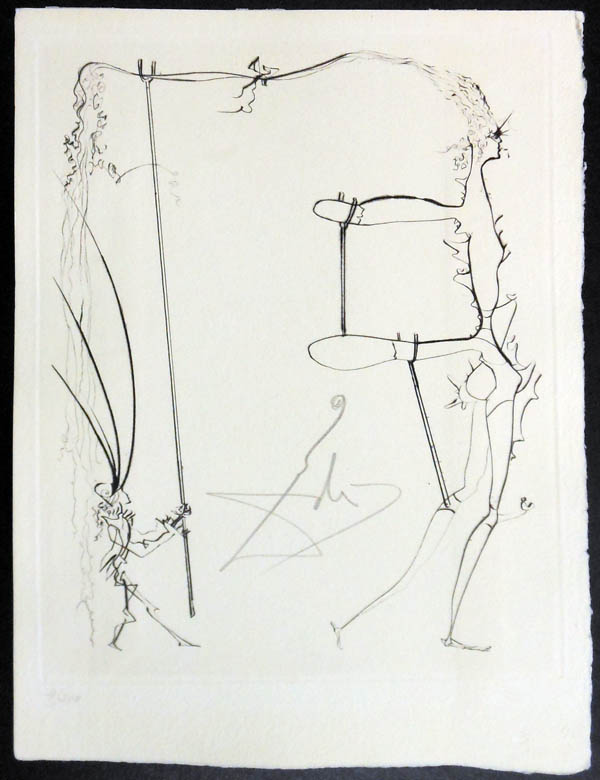Salvador Dali - Vogue
Salvador Dali
Spanish (1904 – 1989)
Vogue 1972
The Salvador Dali Vouge is a drypoint etching. It comes complete with the magazine with the same number. Also, it comes individually without the magazine. Although not well known for his contributions to fashion, Dali did make contributions to the magazine Vogue. Vogue often adorned its cover with well know people and celebrities. Dali was on the cover four different times. In 1971 he contributed an etching for the magazine. The cover featured his face. Of course, Dali was also the editor of this edition. This was the Christmas edition of the magazine.
Vogue Magazine in Paris is the publisher. Rigal did the etching. According to Field, the total tirage is 196. 108 copies of the magazine contain the etching. 12 were sent to Dali. The etching is printed on Auvergne. Dali signed the etchings. The etching is a magazine insert. As far as I can tell, Dali did not sign the etching that was in the magazine.
The etching we have comes directly from the Rigal collection. On the recto is the marking of the Rigal collection. It reads from “Epreuve faisant partie denotre collection” signed Rigal. The etching size is 12 3/4 x 9 7/8.” The sheet size is 13 x 10″. This is one of the etchings that does not come with the magazine with the same number. It has Dali’s signature.
This is background information,
Dalí was known for his role in Surrealism. He was also a seminal example of celebrity showmanship and the cult of personality, a phenomenon that dominates popular culture today. Dali was always a colorful and flamboyant presence. This is reflected by his signature cape, wide-eyed expression and trademark upturned waxed mustache, Dalí was a master of self-promotion and spectacle. For additional background information related to Salvador Dali Vogue click on this link for more information.
This is the tirage for Vogue
According to Lopsinger, the total tirage is 226. 200 copies of the magazine contain the etching. While 26 copies are separate. These separate versions contain the mark epurves d’ artist. The numbering is A – Z. Welcome to the world of Dali.
This is information on the drypoint process.
Vogue was created using the drypoint process. In the drypoint process, Dali could sketch an idea onto a blank copper or zinc plate. He used a diamond point or another sharp tool. The incised lines would then hold and print the ink. Etching lines are typically the same width from one end to the other.
Drypoint lines vary in their width, darkness and may skip. In an early pull from the plate, the sides of the lines may exhibit the heavy, fuzzy quality created by the ink held in the burr that was pushed up along the length of the line by the diamond point. It’s much like the berm of earth pushed to the side by a farmer’s plow. The published prints the plate. The plate is then wiped. The burr wears down and a graphic printed later in the edition will have lost its burr. The etching looses the dark velvety quality of some of its lines. It will then look more like an etching to the untrained eye.
Etched lines end with a blunt end, not a pointed end. Pointed ends will indicate drypoints or possibly engravings. Unless there have been multiple steps in etching the plate, etched lines will be pretty much the same width and darkness over the surface of the print. Drypoint lines will vary.
Call us for more information. The etching is Sold!!!
Click on the thumbnail for a larger image.
Go to the main Individual Works Page for complete etching information.



